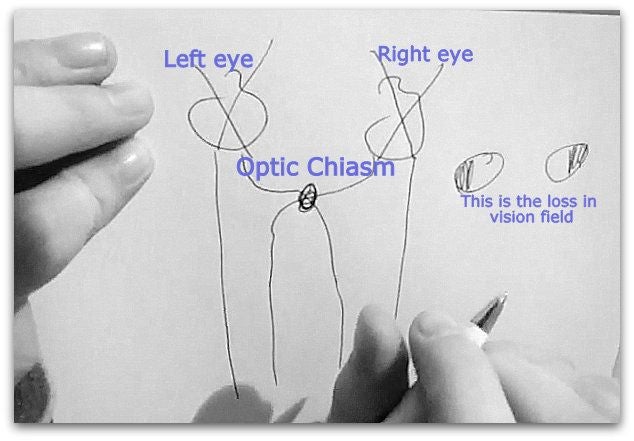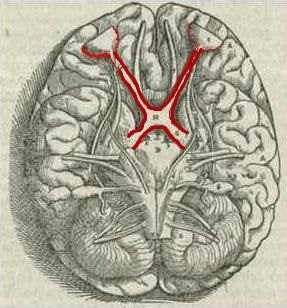Cerebral Vision Impairment
Cerebral Visual Impairment (commonly referred to as CVI) is a form of visual impairment caused by the brain not being able to process information from the eyes passing along the visual pathways in the brain.
It is caused by visual disturbances arising from a brain disorder or brain injury beyond the point where the optic nerves cross each other (optic chiasm). When the brain cannot process or interpret in a wrong way the images they receive from the eyes, it is called CVI. There is nothing wrong with the eyes.
Characteristic: CVI is not static
The disturbance of vision range from changing visual acuity, blurred vision, poor vision, impaired eye movements, reduced detail, failure to recognize objects or faces, difficulty orienting and loss of vision.
The complaints of visual acuity can change very often, that it is difficult to gauge for others. But the person him-/herself often does not know what he/she sees. The visio change can be caused, for example, by the physical condition or by overstimulation.
That these vison complaints can change makes this condition even so misunderstood. CVI is not static. The change what someone sees may occur very gradually but also rapidly on a day. Over stimulation (flooding) plays a big role in this.
About Compensating
Someone with CVI wrote: "Certainly I am visually impaired but I can overcompensate very well, even so that someone who does not know will not notice that I see very bad. But I am certainly affected by it.."
Example
An underestimated phenomenon is that seeing things or not seeing things, does not have much to do with dimensions of things. But simply whether the brain does process the signals or not. For example, someone can miss out a person completely miss but does see a pen.
The video below shows that we all can miss something totally, while we are watching. What does your brain register ? Take the test! The question is how many times the white team throws the ball ....
If the video is not visible on your mobile / cell phone or tablet please click here: Test Your Awareness:
Where the optic nerves cross: optic chiasm
The optic chiasm is a flat body in the frontal lobe and makes visual information available for both hemispheres. Stimuli from the retina of the eye enter in the optic chiasm through the optic nerves, and be sent to the thalamus, and from there the information is relayed to the primary visual cortex.
It depends on where the injury or the pressure is, where the part of the field of vision is blocked.

Chiasm is derived from the Greek letter 'X', Chi, χίασμα, 'crossing', χιάζω 'at the cross X':
A drawing from 1543 of Andreas Vesalius shows that intersection X (the optic chiasm) in red. You can see the bottom of the brain; the eyes are in the top of this drawing.
↓

Disorders of the pituitary gland, the nerve fibers in the optic nerve crossing, the chiasm, which lies just above the pituitary gland, by which a part of the field of vision may fall out. As a result, portion of field of vision can be omitted.
But there may also be damage somewhere around the nerve to the visual cortex (Optic radiation) or in the occipital lobe, where visual information is processed.
Causes
There are several causes in adults such as after a stroke (CVA), Multiple Sclerosis, brain tumor, injury or infection.
If a space-occupying lesion occurs from the pituitary gland, it does not only give headaches, but also pressure on the optic chiasm. Half-sided visual field loss in the outside of both eyes (bitemporal hemianopia) and loss of vision may occur.
There may also be pressure on the nerve that normally let the move in all directions. (Oculomotoric nerve). Then ocular muscle weakness / paralysis (ophthalmoplegia ) can emerge.
Crowding
Crowding is the phenomenon in which someone can no longer perceive visual stimuli separately while they are close to each other, due to a limitation in the selective attention system.
This means that in case a lot of visual information will reach a person at the same time (simultaneous perception), it is difficult for the brain to select the correct information.
If the ocular motor skills are disturbed, for example due to involuntary wiggling of the eyes (nystagmus) this will increase the problem.
Someone with CVI often cannot focus properly on one point (fixation). Visual acuity can also change in such a way that a symbol among other symbols in a row or in a group is less visible. It is better to show these one by one or individually.
See example below:
Itisverydifficulttoreadtextsforsomeonewhocanseewelliftherearenocommasorfullstopsandcapitals!
Because CVI is such a broad term, the symptoms are diverse, depending on location, and nature of injury:
- difficulty with orienting
- difficulty recognizing objects
- difficulty recognizing faces
- difficulty recognizing facial expressions
- difficulty recognizing shapes, symbols or images
- difficulty in recognizing characters
- difficulty seeing anything against a busy background as eg. a print pattern
- difficulty to find something among other things
- difficulty seeing someone in a crowd
- difficulty identifying colors
- varying acuity, blurred vision that can change
- reduced view details
- difficulty realms of objects and grasping objects
- blind spots in the vision
- visual field loss
In children, CVI can be caused by lack of oxygen at birth. Because the brain is still developing the functions can often still be taken over by other brain areas. Exercises, strategies and experiences can compensate a lot, but the parents or teachers must first be aware that the child's vision can change so often.
In an adult however, the brain is already fully developed. If in an adult person CVI is caused by brain injury or a brain disease, it is impossible to predict whether this person will learn to cope with vision complaints
Real Life Stories
Read real life stories from parents who have a child with CVI on CVI society.
More links: